Haryana Board Solutions For Class 7 Maths Chapter 5 Understanding Elementary Shapes
- A line segment is a part of line with two end points.
- A triangle is made of three line segments.
- A quadrilateral is made of four line segments.
- It is possible to measure a line segment. The measure of each line segment is its ‘length’.
- We can compare the length of two line segments by a) Simple observation, b) Tracing on a paper and comparing, c) Using instruments.
- The instruments used to compare and draw line segments are ruler (Scale) and divider in the Geometry box.
- The unit of measuring length is 1 centimeter (1 cm.) 1 cm = 10 mm.
- Angle is formed between two rays or two line segments.
- A protractor is a semi circular curved model with 180 equal divisions used to measure and construct angles.
- The unit of measuring an angle is a degree (1°). It is \(\frac{1}{360}\)th part of one revolution.
- Kinds of Angles:
- An angle whose measure is 90° is called. “Right angle”.
- An angle whose measure is 180° is called “Straight angle”. (= 180°)
- An angle is ‘acute’ if its measure is smaller than that of a right angle. (< 90°)
- An angle is ‘obtuse’ if its measure is more than that of a right angle and less than a straight angle. (>90° and < 180°)
- A ‘reflex angle’ is more than a straight angle. (>180° and < 360°)…
- If the angle measure is ‘O’ then it is called ‘Zero angle’.
- If the measure of the angle is 360° then it is called ‘Complete angle’. (= 360°)
- Angles where the ray moves in the opposite direction of the hands of a clock are called “Anti clock – wise angles”.
- Angles where the ray moves in the direction of the hands of a clock are called “clock- wise angles”.
- Two distinct lines of a plane which have a common point are “intersecting lines”.
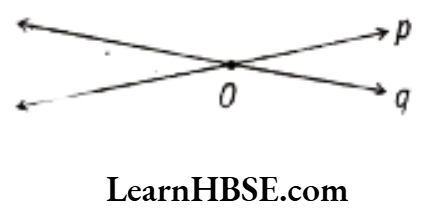
- Two intersecting lines are perpendicular if the angle between them is a right angle.
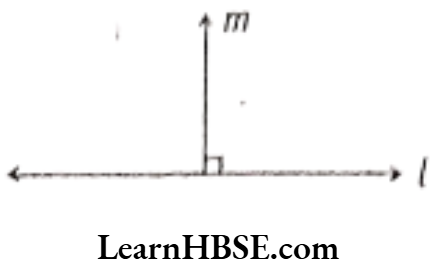
Haryana Board Class 7 Maths Understanding Elementary Shapes solutions
- If two lines on a plane do not intersect each other at any point, they are called parallel lines.
l and m are parallel lines.
We write it as l || m and read it as l is parallel to m. - Two parallel lines do not have any common point.
Symbols:
|| – Parallel
⊥ – Perpendicular - A ‘polygon’ is a closed figure made up of line segments.
- A polygon with all equal sides and all equal angles is called a regular polygon.
- Eg Equilateral triangle, Square & etc.
- Plane: A plane is the two-dimensional flat surface that extends infinitely far.
Eg: Wall, blackboard, paper. …….. etc. - In ‘polygons’ poly means ‘many’, gons means ‘sides’. Polygons means ‘many sides’.
- A polygon is a closed figure in the plane with at least three line segments and typically four or more.
Eg: Triangle, quadrilateral, pentagon, hexagon, heptagon, octagon, nanogon and decagon are some of the polygons. - The simple closed figure formed by three line segments is called a triangle. The line segments are called sides.
A triangle contains three sides, three angles and three vertices. A triangle is denoted by the symbol “A”.

- Triangular regions: A triangle divides the points on the plane into three parts.
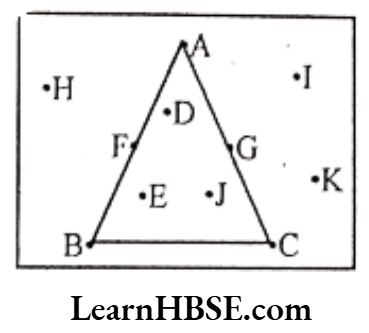
- Interior points of the triangle – D, E, J
- Points on the triangle – G, F, A, B, C
- Exterior points of the triangle – H, I, K
Quadrilateral: A polygon with four sides is called a quadrilateral. Quadra means four, lateral means ‘side’. In quadrilateral ABCD, four line segments
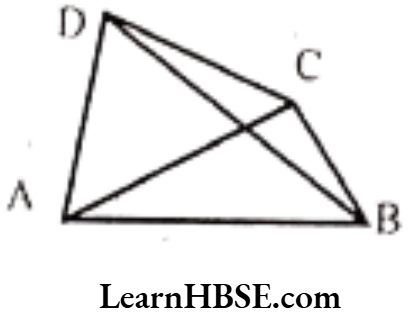
\(\overline{\mathrm{AB}}, \overline{\mathrm{BC}}, \overline{\mathrm{CD}} \text { and } \overline{\mathrm{DA}}\) are called sides and ∠A, ∠B, ∠C and ∠D are its four angles. Points A,B,C and D are its vertices. The line segments AC and BD are called its diagonals
- 1 mm = 0.1 cm.
- A triangle having all the three unequal sides is called a scalene triangle.
- A triangle having two equal sides is called an isosceles triangle.
- A triangle having three equal sides is called an equilateral triangle.
- A cuboid has 6 faces, each face has 4 edges. Each face has 4 corners.
- A polygon with 6 sides is called Hexagon.
- A polygon with 8 sides is called Octagon. A parallelogram with 4 sides of equal length is called Rhombus.
- A Rhombus with 4 right angles is called square..
- Study the table given below and observe the names of various types of polygons.
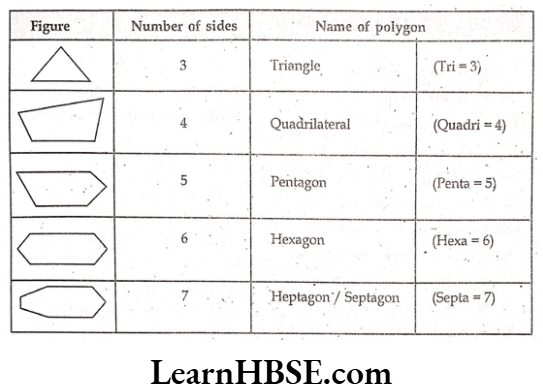
Types of angles and triangles Class 7 HBSE Maths
Question 1. Take any post card. Use the above technique to measure its two adjacent. sides.
Solution. Post card length – 14 cm.
Breadth – 9.5 cm.
Yes, all post cards have the same dimensions.
Question 2. Select any three objects having a flat top. Measure all sides of the top using a divider and a ruler.
Solution.
Three objects:
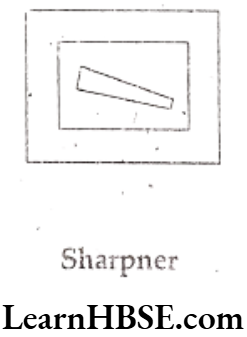
Length = 2.7 cm.
Breadth = 2 cm.
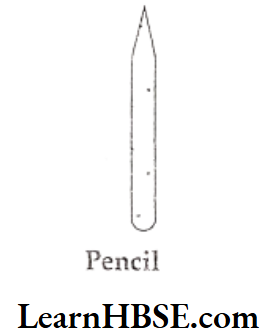
Length = 5.2cm.
Breadth = 1 cm.
3) Eraser
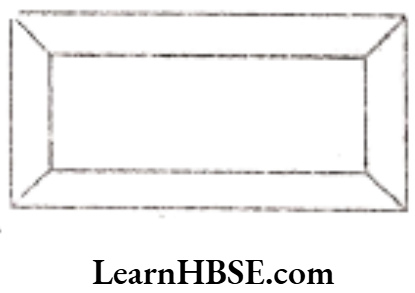
Length = 2.4 cm.
Breadth = 1 cm.
Haryana Board Solutions For Class 7 Maths Chapter 5 Understanding Elementary Shapes Exercise 5.1
Question 1. What is the disadvantage in comparing line segments by mere observation?
Solution. Sometimes the difference in lengths between two line segments is not obvious with our eyes. So, we are not always sure about the judgement.
Question 2. Why is it better to use a divider than a ruler, while measuring the length of a line segment?
Solution. The errors are due to the thickness of the ruler and angular viewing by using a ruler. These errors are eradicated by using a divider. So, it is better to use a divider, while measuring the length of a line segment.
Question 3. Draw any line segment, say \(\overline{\mathrm{AB}}\). Take any point C lying in between A and B. Measure the lengths of AB, BC and AC. Is AB = AC+ CB?
(Note: If A, B, C are any three points on a line such that AC+ CB= AB, then we can be sure that C lies between A and B.) A
Solution.
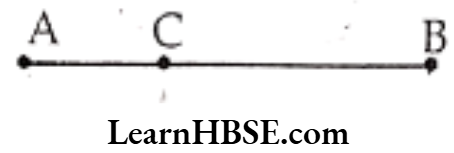
Length of AB = 5 cm
Length of BC = 3 cm
Length of AC = 2 cm.
AC + BC = 2 cm + 3 cm = 5cm = AB
∴ AC + BC = AB
Question 4. If A, B, C are three points on a line such that AB = 5 cm, BC = 3 cm and AC = 8 cm, which one of them lies between the other two?

Solution. The point B lies between the point A and C.
Question 5. Verify, whether D is the mid point of \(\overline{\mathrm{AG}}\)
Solution.
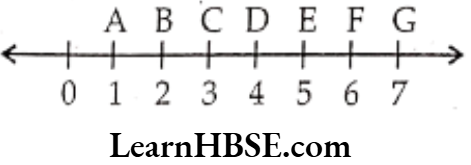
Yes! D is the mid point of \(\overline{\mathrm{AG}}\). (A to G = 7)
Question 6. If B is the mid point of \(\overline{\mathrm{AC}}\) and C is the mid point of \(\overline{\mathrm{AC}}\), where A, B, C, D lie on a straight line, say why AB = CD? C D
Solution.

∴ B is the mid point of \(\overline{\mathrm{AC}}\)
∴ AB = BC. ……(1)
∴ C is the mid point of \(\overline{\mathrm{AC}}\)
∴ BC = CD …….. (2)
From (1) &(2) AB = BC = CD ⇒ AB = CD
Question 7. Draw five triangles and measure their sides. Check in each case, if the sum of the lengths of any two sides is always less than the third side.
Solution.
1)
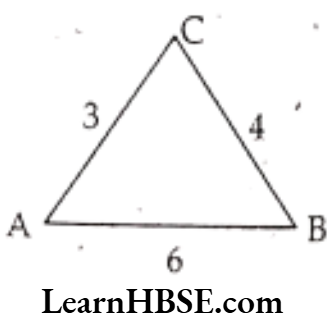
AB + BC = 6 + 4 = 10 cm is not less than AC = 3 cm
2)
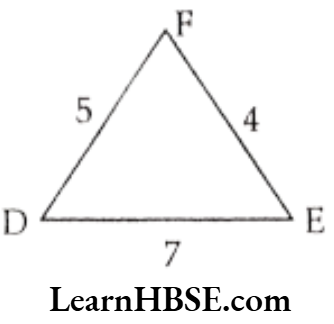
DF + DE = 5 + 7 = 12 cm is not less than EF = 4 cm.
3)
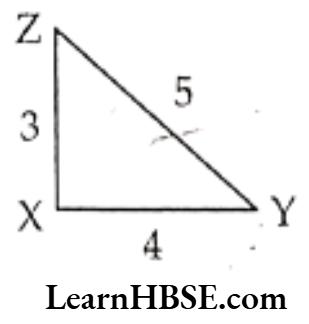
XY + ZY = 4 + 5 = 9 cm is not less than XZ = 3 cm
4)

AB + AC = 3 + 6 = 9 cm is not less than BC = 8 cm.
5)

PQ + PR = 8 + 17 = 25 cm is not less than QR = 15 cm. It is not possible to construct a triangle with one side more than the total of the other two sides.
Question 8. What is the angle name for half a revolution?
Solution. 180°.
Question 9. What is the angle name for one-fourth revolution?
Solution. 90°.
Question 10. Draw five other situations of one-fourth, half and three-fourth revolution on a clock.
Solution.
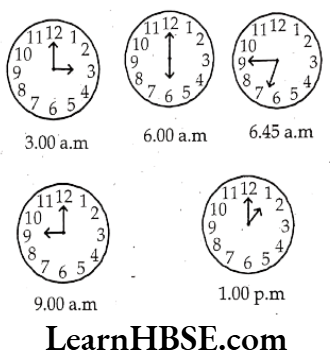
Haryana Board Solutions For Class 7 Maths Chapter 5 Understanding Elementary Shapes Exercise – 5.2
Question 1. What fraction of a clock wise revolution does the hour hand of a clock turn through, when it goes from
a) 3 to 9
b) 4 to 7
c) 7 to 10
d) 12 to 9
e) 1 to 10
f) 6 to 3
Solution. a) 1/2 of a revolution.
b) 1/4 of a revolution
c) 1/4 of a revolution
d) 3/4 of a revolution
e) 3/4 of a revolution
f) 3/4 of a revolution
Question 2. Where will the hand of a clock stop if it
a) Starts at 12 and makes 1/2 of a revolution, clockwise?
Solution. 6
b) Starts at 2 and makes 1/2 of a revolution, clockwise?
Solution. 8
c) Starts at 5 and makes 1/4 of a revolution, clockwise?
Solution. 8
d) Starts at 5 and makes 3/4 of a revolution, clockwise?
Solution. 2
Question 3. Which direction will you face if you start facing
a) East and make 1/2 of a revolution
Solution. West
b) East and make 1%, of a revolution clockwise?
Solution. West
c) West and make 3/4 of revolution anti-clock wise?
Solution. North.
d) South and make one full revolution?
Solution. South
(Should we specify clockwise or anti-clockwise for this last question? Why not?)
No, since the result of both types of revolutions is the same.
Question 4. What part of a revolution have you turned through if you stand facing
a) East and turn clockwise to face north?
Solution. 3/4 of a revolution.
b) South and turn clockwise to face east?
Solution. 3/4 of a revolution
c) West and turn clockwise to face east?
Solution. 1/2 of a revolution.
Question 5. Find the number of right angles turned through by the hour hand of a clock when it goes from
a) 3 to 6
Solution. 1 right angle
b) 2 to 8
Solution. 2 right angles
c) 5 to 11
Solution. 2 right angles
d) 10 to 1
Solution. 1 right angle
e) 12 to 9
Solution. 3 right angles
f) 12 to 6
Solution. 2 right angles.
Question 6. How many right angles do you make if you start facing
a) south and turn clockwise to west?
Solution. 1 right angle.
b) north and turn anti-clockwise to east?
Solution. 3 right angles.
c) west and turn to west?
Solution. 4 right angles.
d) south and turn to north?
Solution. 2 right angles.
Question 7. Where will the hours hand of a clock stop if it starts.
a) from 6 and turns through 1 right angle?
Solution. 9
b) from 8 and turns through 2 right angles ?
Solution. 2
c) from 10 and turns through 3 right angles ?
Solution. 7
d) from 7 and turns through 2 straight angles ?
Solution. 1
Question 8. Are there angles smaller than a right angle?
Solution. Yes. Acute angle (<90°)
Question 9. Are there angles greater than a right angle?
Solution. Yes. Obtuse angle (>90° and <180°)
Question 10. The hour hand of a clock moves from 12 to 5.
Is the revolution of the hour hand more than 1 right angle?
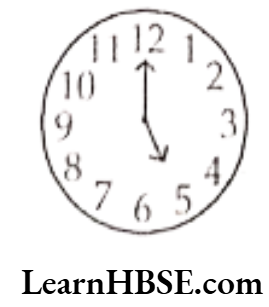
Solution. Yes.
Question 11. What does the angle made by the hour hand of the clock look like when it moves from 5 to 7. Is the angle moved more than 1 right angle?
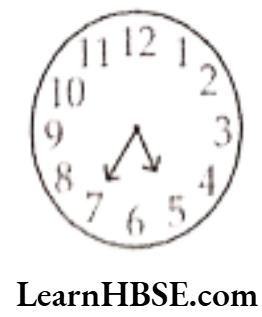
Solution. The angle made by the hour hand looks like on acute angle. No, the angle moved by the hour hand is less than 1 right Sol. Opening of a book, roof top, when the angle.
Question 12. Look around you and identify edges meeting at corners to produce angles. List such situations.
Solution. Edge of a book, edge of a wall, edge of a table.
Question 13. List three situations where the angles made are acute.
Solution. Opening of a book, roof top, when the time in a clock is 3 hours 5 min.
Question 14. List three situations where the angles made are right angles.
Solution. The angle between two edges of a table, corners of room, when a pole is placed vertically on the ground.
Question 15. Find three situations where obtuse angles are made.
Solution. House, book reading desk, the angle between two hands of a clock if the time is 2 hours 55 min.
Question 16. List three situations where reflex angles may be seen.
Solution.
1) The angle between two hands of a clock if the time is 12 hours 40 min.
2) The angle made by the sector in the alternate segment at the centre.
3) The angle between two hands of a clock if the time is 5 hours.
Haryana Board Solutions For Class 7 Maths Chapter 5 Understanding Elementary Shapes Exercise – 5.3
Question 1. Classify each one of the following angles as right, straight, acute, obtuse or reflex:
Solution.

a) Acute b) Obtuse c) Right angle d) Reflex e) Straight f) Acute
Question 2. How many degrees are there in half a revolution? In one right angle? In one straight angle?
Solution. Half a revolution = 180°; Right angle = 90°; Straight angle = 180°
Question 3. How many right angles make 180° ? 360° ?
Solution. 2 right angles make 180° [90° x 2]
4 right angles make 360° [90° 4]
Chapter 5 Understanding Elementary Shapes Exercise – 5.4
Question 1. What is the measure of
(1) a right angle?
(2) a straight angle?
Solution. 1) The measure of a right angle is 90°.
2) The measure of a straight angle is 180°.
Question 2. Say True or False:
a) The measure of an acute angle < 90°.
Solution. True.
b) The measure of an obtuse angle. < 90°.
Solution. False.
c) The measure of a reflex angle > 180°.
Solution. True.
d) The measure of one complete revolution = 360°.
Solution. True.
e) If m∠A = 53° and m∠B = 35° then m∠A > m∠B.
Solution. True.
Question 3. Write down the measures of (a) some acute angles. (b) some obtuse angles.
(give atleast two examples of each.)
Solution. a) 30°, 85°
b) 110°, 170°
Question 4. Measure the angles given below using the Protractor and write down the measure.
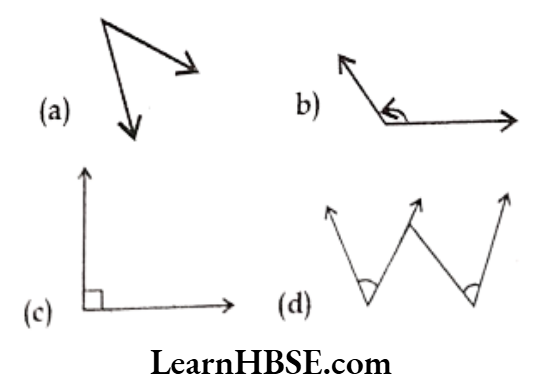
Solution. a) 45°
b) 1280
c).90°
d) 65°
Polygons and their properties Class 7 Haryana Board
Question 5. Which angle has a large measure? First estimate and then measure.
Measure of Angle A =
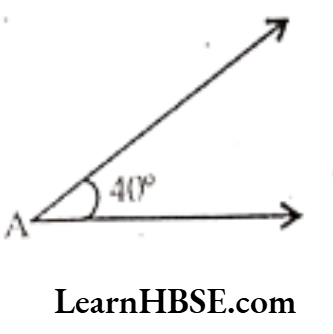
Measure of Angle B =
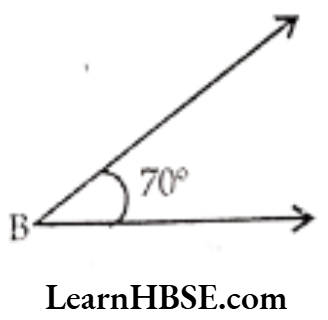
Solution. Measure of angle A = 40°
Measure of angle B = 70°
∴ The angle B is a larger measure.
Question 6. From these two angles which has larger measure? Estimate and then confirm by measuring them.
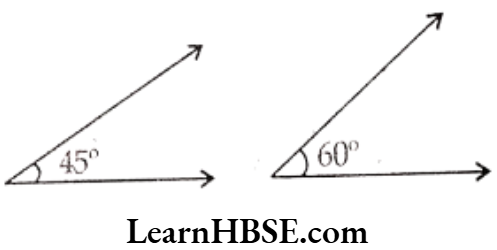
Solution. Measure of first angle = 45°
Measure of second angle = 60°
Second angle has larger measure.
Question 7. Fill in the blanks with acute, obtuse, right or straight.
a) An angle whose measure is less than that of a right angle is _____
Answer. acute
b) An angle whose measure is greater than that of a right angle is _____
Answer. obtuse
c) An angle whose measure is the sum of the measures of two right angles is _____
Answer. straight
d) When the sum of the measures of two angles is that of a right angle, then each one of them is.
Answer. acute
e) When the sum of the measures of two angles is that of a straight angle and if one of them is acute then the other should be ___________ or ___________
Answer. acute or obtuse
Question 8. Find the measure of the angle shown in each figure (first estimate with your eyes and then find the actual measure with a protractor).
Solution.
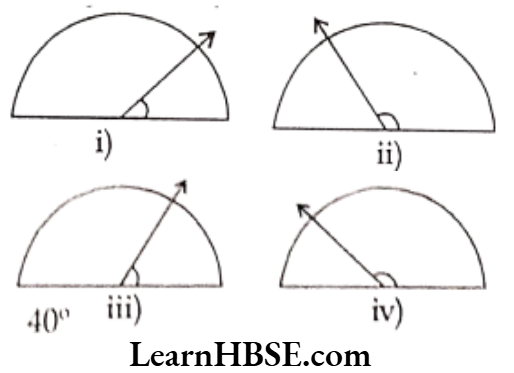
1) 40°
2) 130°
3) 65°
4) 140°
Question 9. Find the angle measure between the hands of the clock in each figure:
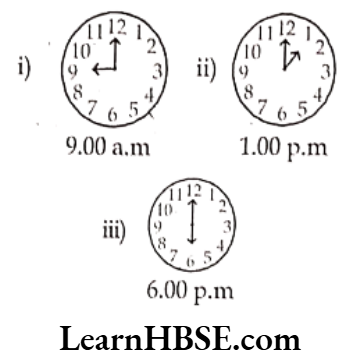
Solution.
(1) 90°
(2) 30°
(3) 180°.
Question 10. Investigate: In the given figure the angle measures 30°. Look at the same figure through a magnifying glass. Does the angle becomes larger? Does the size of the angle change?
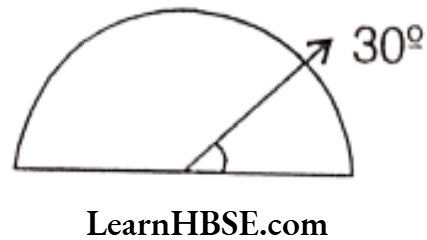
Solution. No.
Question 11. Measure and classify each angle:
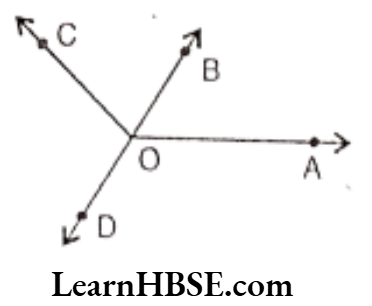

Solution.

Haryana Board Solutions For Class 7 Maths Chapter 5 Understanding Elementary Shapes Exercise – 5.5
Question 1. Which of the following are models for perpendicular lines:
a) The adjacent edges of a table top.
Solution. a) Perpendicular lines
b) The lines of a railway track.
Solution. b) Not perpendicular lines.
c) The line segments forming the letter “L”.
Solution. Perpendicular lines.
d) The letter V.
Solution. Not perpendicular.
Question 2. Let \(\overline{\mathrm{PQ}}\) be the perpendicular to the line segment \(\overline{\mathrm{XY}}\).Let \(\overline{\mathrm{PQ}}\) and \(\overline{\mathrm{XY}}\) intersect in the point A. What is the measure of ∠PAY?
Solution. The point A is placed in \(\overline{\mathrm{XY}}\) such that it is placed in \(\overline{\mathrm{PQ}}\) also.
Measure of ∠PAY is 90°.
Question 3. There are two set squares in your box. What are the measures of the angles that are formed at their corners? Do they have any angle measure that is common?
Solution. The angles are 90°, 30°, 60°, 90°, 45°, 45° Yes, they have angle measure 90° as common.
Question 4. Study the diagram. The line l is perpendicular to line m.
a) Is CE = EG?
Solution. CE = 5 -3 = 2
EG = 7 – 5 = 2
Yes. CE = EG
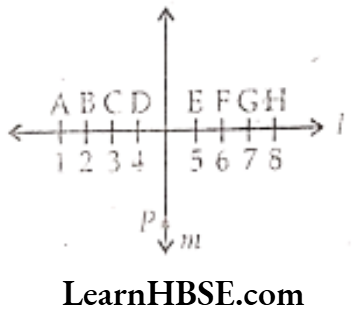
b) Does PE bisect CG?
Solution. Yes
c) Identify any two line segments for which PE is the perpendicular bisector.
Solution. \(\overline{P E}\) bisects \(\overline{D F}\)
\(\overline{P E}\) bisects \(\overline{B H}\)
d) Are these true?
1) AC > FG Solution. Yes
2) CD = GH Solution. Yes
3) BC < EH Solution. Yes
Haryana Board Solutions For Class 7 Maths Chapter 5 Understanding Elementary Shapes Exercise – 5.6
Question 1. Name the types of following triangles:
a) Triangle with lengths of sides 7 cm, 8 cm and 9 cm.
Solution. Scalene.
b) ∠ABC with AB = 8.7 cm, AC = 7 cm and BC = 6 cm.
Solution. Scalene.
c) ∠PQR such that PQ = QR = PR=5 cm.
Solution. Equilateral.
d) ΔDEF with m∠D = 90°
Solution. Right angled triangle.
e) ΔXYZ with m∠Y=90° and XY = YZ.
Solution. Isosceles right angled.
f) ALMN with m∠L = 30° and m∠m = 70° and m∠N = 80°.
Solution. Acute
Question 2. Match the following:

Solution. 1 – e, 2 – g, 3 – a, 4 – f, 5 – d, 6 – c, 7 – b
Question 3. Name each of the following triangles in two different ways: (You may judge the nature

Solution. a) Isosceles triangle, acute angled triangle.
b) Right angled triangle, scalene triangle.
c) Obtuse angled triangle, isosceles triangle.
d) Right angled isosceles triangle, isosceles triangle.
e) Equilateral triangle, acute angled triangle.
f) Obtuse angled triangle, scalene triangle.
Question 4. Try to construct triangles using match sticks. Some are shown here.
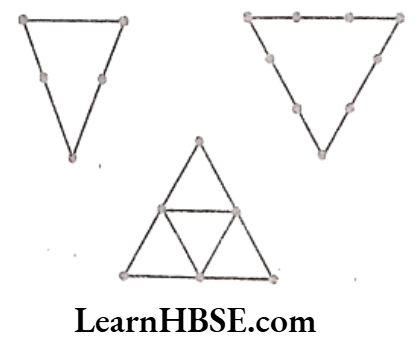
Can you make a triangle with
a) 3 match sticks?
Solution. Yes
b) 4 match sticks?
Solution. No
c) 5 match sticks?
Solution. Yes
d) 6 match sticks?
Solution. Yes.
- With 3 match sticks, the triangle so formed is an equilateral triangle.
- With 5. match sticks, the triangle so formed is an isosceles triangle.
- With 6 match sticks, the triangle so formed is an equilateral triangle.
3D shapes faces edges and vertices Class 7 HBSE
Question 5. Place a pair of unequal sticks such that they have their end point joined at one end. Now place another such pair meeting the free ends of the first pair.
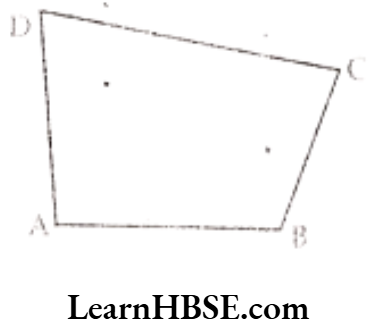
What is the figure enclosed
It is a quadrilateral, like the one you see here.
The sides of the quadrilateral are \(\overline{\mathrm{AB}}, \overline{\mathrm{BC}}\)__,__,.
There are 4 angles for this quadrilateral.
They are givenby ∠BAD, ∠ADC, ∠DCB and _____
BD is one diagonal. What is the other? Measure the length of the sides and the diagonals.
Measure all the angles also.
Solution. The enclosed figure is quadrilateral whose sides are \(\overline{\mathrm{AB}}, \overline{\mathrm{BC}}, \overline{\mathrm{CD}}, \overline{\mathrm{DA}}\).
The 4 angles of the quadrialteral are ∠BAD, ∠ADC, ∠DCB, ∠ABC.
\(\overline{\mathrm{BD}}\) is one diagonal. The other diagonal is \(\overline{\mathrm{AC}}\)
The measures of length of the side diagonals and angles are as follows
AB = 2.8 cm
BC = 2 cm
CD = 3.3 cm
DA = 3.9 cm
AC = 3.8 cm
BD = 4 cm
∠ABC = 110°
∠BCD = 100°
∠CAD = 60°
∠DAB = 90°
Question 6. Using four unequal sticks, as you did in the above activity, see if you can form a quadrilateral such that
a) all the four angles is acute.
Solution. No
b) one of the angles is obtuse
Solution. Yes.
c) one of the angles is right angled.
Solution. Yes.
d) two of the angles are obtuse.
Solution. Yes
e) two of the angles are right angled.
Solution. Yes
f) the diagonals are perpendicular to one another.
Solution. Yes.
Haryana Board Solutions For Class 7 Maths Chapter 5 Understanding Elementary Shapes Exercise – 5.7
Question 1. Say True or False:
a) Each angle of a rectangle is a right angle.
Solution. True
b) The opposite sides of a rectangle are equal in length.
Solution. True
c) The diagonals of a square are perpendicular to one another.
Solution. True
d) All the sides of a rhombus are of equal length.
Solution. True
e) All the sides of a parallelogram are of equal length.
Solution. False.
f) The opposite sides of a trapezium are parallel.
Solution. False.
Question 2. Give reasons for the following:
a) A square can be thought of as a special rectangle.
Solution. Yes, because all the sides are equal.
b) A rectangle can be thought of as a special parallelogram.
Solution. Yes, because each angle is 90°.
c) A square can be thought of as a special rhombus.
Solution. Yes, the diagonals are of equal length.
d) Squares, rectangles, parallelograms are all quadrilaterals.
Solution. Yes, because all are of four sides.
e) Square is also a parallelogram.
Solution. Yes, each angle is 90° and all the sides are of equal length.
Question 3. A figure is said to be regular if its sides are equal in length and angles are equal in measure. Can you identify the regular quadrilateral ?
Solution. Square is a regular quadrilateral
Haryana Board Solutions For Class 7 Maths Chapter 5 Understanding Elementary Shapes Exercise – 5.8
Question 1. Examine whether the following are polygons. If any one among them is not, say why?
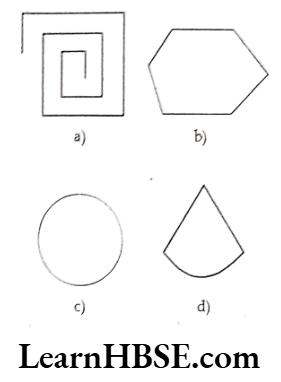
Solution. a) Not a polygon.
b) Polygon.
c) Not a polygon.
d) Not a polygon.
Question 2. Name each polygon.
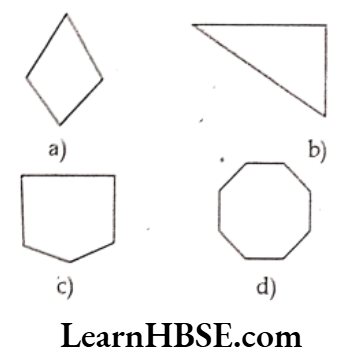
Solution. a) Quadrilateral.
b) Triangle.
c) Pentagon.
d) Octagon.
Question 3. Draw a rough sketch of a regular hexagon. Connecting any three of its vertices, draw a triangle. Identify the type of the triangle you have drawn.
Solution.

The triangle drawn is an obtuse angled triangle.
Question 4. Draw a rough sketch of a regular octagon. (Use squared paper if you wish). Draw a rectangle by joining exactly four of the vertices of the octagon.
Solution.

Question 5. A diagonal is a line segment that joins any two vertices of the polygon and is not a side of the polygon. Draw a rough sketch of a pentagon and draw its diagonals.
Solution.
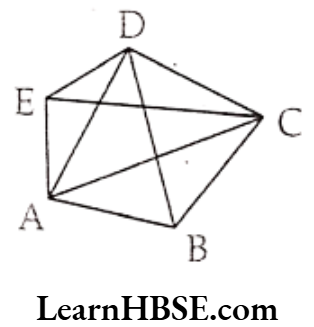
Haryana Board Solutions For Class 7 Maths Chapter 5 Understanding Elementary Shapes Very Short Answer Questions
Question 1. In the adjacent figure ∠AOB and ∠AOC are given. Which angle is clock wise and which angle is anti-clock wise?
Think and discuss with your friends

Solution. ∠AOB → Clock wise angle.
∠AOC → Anti-clock wise angle.
Question 2. Which are obtuse angles?
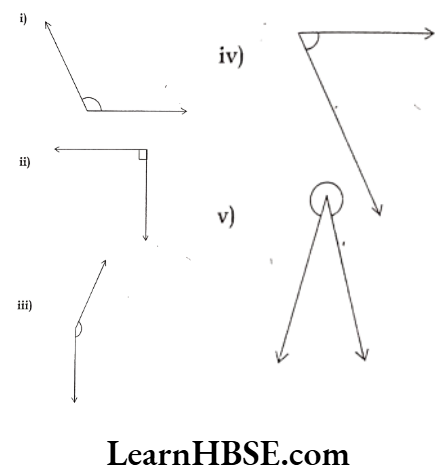
Solution. Obtuse angles: (1), (3), (5)
Question 3. Draw any two acute and two obtuse
Solution.
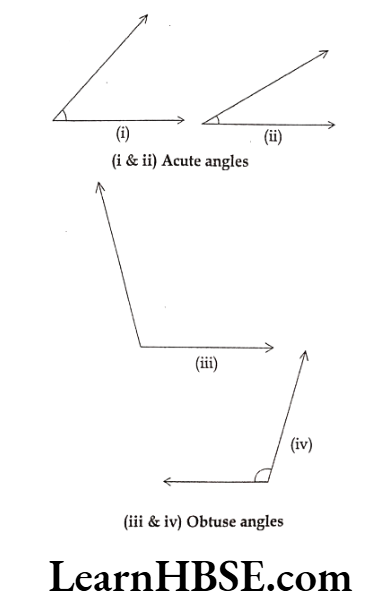
Question 4. Draw any two separate lines in a plane. Do they intersect at more than one point?
Solution.
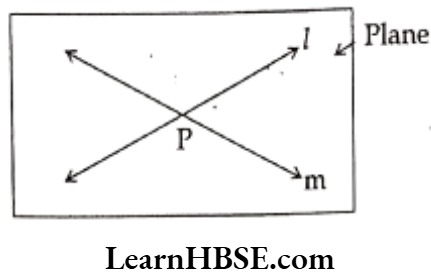
1, m are two separate lines in a plane. They intersect at only one point ‘P’.
Question 5. If 11m then we can say that ml?
Solution. Yes.
If l ⊥ m then m ⊥ l.
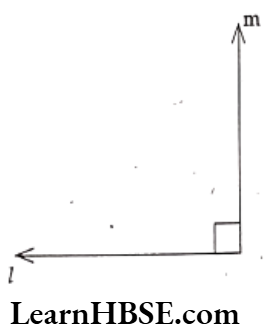
Question 6. How many perpendicular lines can be drawn to a given line?
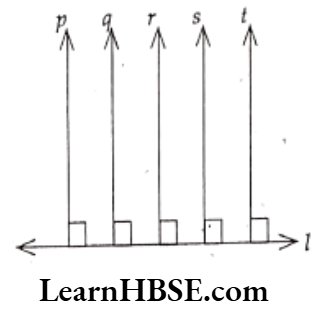
Solution. Many lines can be drawn.
l is the given line.
p, q, r, s, t, are perpendicular lines. So we can draw many perpendicular lines to a given line.
Question 7. Which letters in English alphabets possess perpendicularity?
Solution. In English alphabet the letters E, L, H, F,T possess perpendicularity.
Question 8. Make a pair of parallel lines what is the angle formed between them?
Solution.
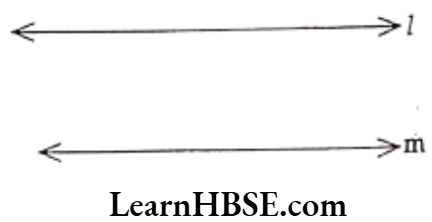
l and m are parallel lines.
Angle between them is 0°.
Question 9. How do you measure the length of a line segment by using a ruler.

Solution. Place the zero mark (cm) of the scale or ruler at A. Read the mark against B.
This gives the length of AB line segment.
Length of \(\overline{\mathrm{AB}}\) = 4 cm
Question 10. By observing your class room, write two examples for right angles.
Solution. 1) Angle between floor and walls.
2) Angle between floor and doors.
Question 11. Answer the following questions.
1) What is the measure of the angle made by the seconds hand in 1 minute?
Solution. 360°.
2) What is the measure of the angle made by the hour hand in 1 hour?
Solution. 30°.
Haryana Board Solutions For Class 7 Maths Chapter 5 Understanding Elementary Shapes Short Answer Questions
Question 1. Use the straw angle apparatus and identify the following angles.

Solution. 1) Obtuse angle
2) Right angle
3) Acute angle.
4) Obtuse angle
Question 2. List out five daily life situations where you observe acute angle and obtuse angles.
Solution. 1) Acute angle: Stem of a plant with the leaf, V shaped Grill of a window, ladder with the floor etc.
2) Obtuse angle: Edge of the Glass with the bottom, Edge of the bucket with the bottom, Table with legs, Flame of the Gas stove, Edges of a bowl with the bottom etc.
Question 3. Draw some angles of your choice. Test them by angle apparatus and write which are acute and which are obtuse.

Solution. 1) obtuse angle
2) → acute angle
3) → acute angle
4) → obtuse angle
Word problems on elementary shapes for Class 7 HBSE
Question 4. Which angles in the adjacent figure are acute. Which are obtuse? Check your estimation by measuring them. Write their measures too.
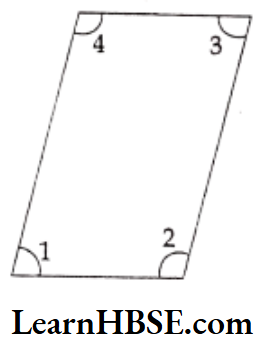
Solution. Acute angles : ∠1 and ∠3
Obtuse angles : ∠2 and ∠4
Measuring :
∠1 = 70°;
∠3=80°
∠2=105°;
∠4=105°
Question 5. Write the type of angle formed between the long hand and short hand of a clock at the given timings.
(Take the small hand as the base)
Solution. 1) At 9 o’clock in the morning – Right angle, 90°
2) At 6 o’ clock in the evening – Straight angle, 180°
3) At 12 noon – Complete angle, 360°
4) At 4 o’ clock in the afternoon – Obtuse angle, 120°
5) At 8 o’clock in the night – Reflex angle, 240°
Question 6. Which of the following are models for parallel lines, perpendicular lines and which are neither of them.
Solution. 1) The vertical window bars : Parallel lines
2) Railway lines : Parallel lines
3) The adjacent edges of doors : Perpendicular lines
4) The letter ‘v’ in English alphabet : Neither of them
5) The opposite edges of Black Board : Parallel lines
Question 7. State the angle between the two hands of a clock, when the time is
Solution. 1) 6 o’clock – 180°
2) 12 o’clock – 0°
3) 3 o’clock – 90°
4) 8 o’ clock – 240°
5) 9 o’clock – 270°
Question 8. Look at the given triangle and answer the following questions.
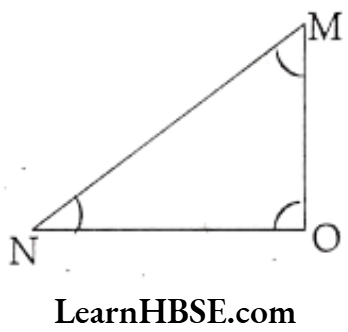
1) How many angles are there in the triangle? What are they?
Solution. 3 angles: They are ∠MNO, ∠NOM and ∠OMN.
2) What is the angle opposite to \(\overline{\mathrm{MN}}\)?
Solution. ∠NOM.
3) Where is the right angle in the given triangle ?
Solution. Right angle is at vertex ‘O’.
Question 9. Look at the adjacent figure, and answer the following questions.
1) What is the name of the triangle?
2) Write all sides, all angles and all vertices of the triangle.
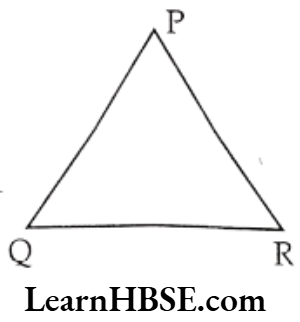
Solution. 1) ΔPQR
2) Sides : \(\overline{\mathrm{PQ}}, \overline{\mathrm{QR}}, \overline{\mathrm{PR}}\)
Angles : ∠PQR, ∠QRS, ∠RPQ.
Vertices : P, Q, R.
Haryana Board Solutions For Class 7 Maths Chapter 5 Understanding Elementary Shapes Long Answer Questions
Question 1. Classify the following angles into acute, right, obtuse and straight angles : 40°, 140°, 90°, 210°, 44°, 215°, 345°, 125°, 10°, 120°, 89°, 270°, 30°, 115°, 180°
Solution. Acute angles: 40°, 44°, 10°, 89°, 30°
(between 0° and 90°)
Right angles: 90°
Obtuse angles: 140°, 125°, 120°, 115°
(between 90° and 180°)
Reflex angles : 210°, 215°, 345°, 270°
(between 180° and 360°)
Straight angle: 180°
Question 2. Write True or False. Correct all those that are False.
1) An angle smaller than right angle is an acute angle.
True
2) A right angle measures 180°
Correct: A right angle measures 90°
False
3) A straight angle measures 90°
Correct: A straight angle measure 180°
False
4) The measure greater than 180° is a reflex angle.
True
5) A complete angle measures 360°
True
Question 3. Match the following angles with measures their. Draw figures for these as well.
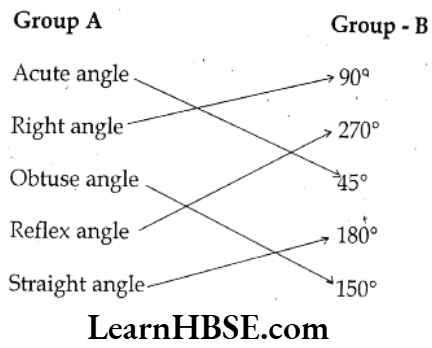
Figures for these:
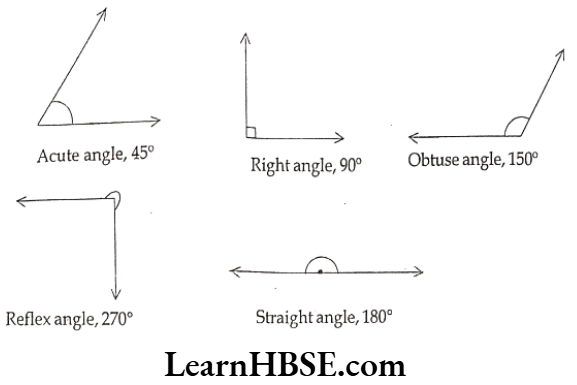
Difference between quadrilaterals and polygons Class 7
Question 4. ABCD is a rectangle. \(\overline{\mathrm{AC}} \text { and } \overline{\mathrm{BD}}\) are diagonals. Write the pairs of parallel lines, perpendicular lines and intersecting lines from the figure in symbolic form.
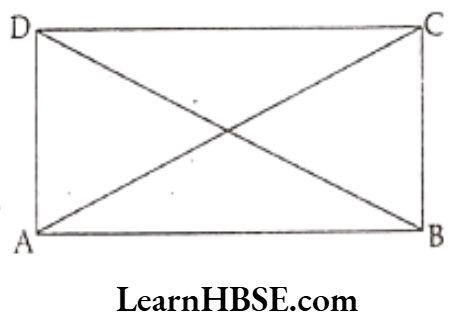
Solution. ABCD is a rectangle.
\(\overline{\mathrm{AC}} \text { and } \overline{\mathrm{BD}}\) are diagonals.
a) Parallel lines : \(\overline{\mathrm{AB}} \text { and } \overline{\mathrm{CD}} ; \overline{\mathrm{AD}} \text { and } \overline{\mathrm{BC}}\)
Symbolic form : \(\overline{\mathrm{AB}}\|\overline{\mathrm{CD}} ; \overline{\mathrm{AD}}\| \overline{\mathrm{BC}}\)
b) Perpendicular lines : \(\overline{\mathrm{AD}}, \overline{\mathrm{AB}} ; \overline{\mathrm{AB}}, \overline{\mathrm{BC}} ; \overline{\mathrm{BC}}, \overline{\mathrm{CD}} ; \overline{\mathrm{CD}}, \overline{\mathrm{DA}}\)
Symbolic form : \(\overline{\mathrm{AD}} \perp \overline{\mathrm{AB}} ; \overline{\mathrm{AB}} \perp \overline{\mathrm{BC}} ; \overline{\mathrm{BC}} \perp \overline{\mathrm{CD}} ; \overline{\mathrm{CD}} \perp \overline{\mathrm{DA}}\)
c) Pair of intersecting line: \(\overline{A C} \text { and } \overline{B D}\)
Question 5. State to which type of angle do the following belong.
Solution.
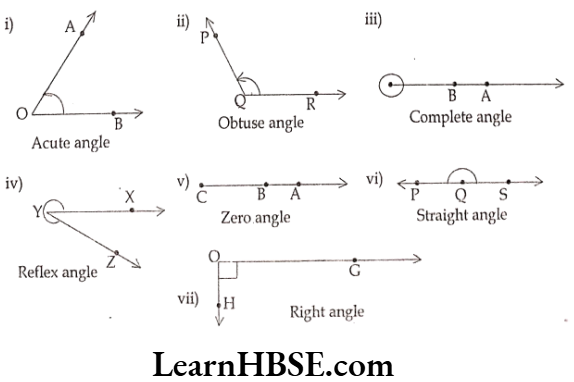
Question 6. Some angle measures are given below. State which kind do each belong.
1) 45°
2) 210°
3) 100°
4) 90°
5) 135°
6) 350°
7) 0°
8) 360°
9) 180°
10) 50°
Solution. 1) 45° – Acute angle
2) 210° – Reflex angle
3) 100° – Obtuse angle
4) 90° – Right angle
5) 135° – Obtuse angle
6) 350° – Reflex angle
7) 0° – Zero angle
8) 360° – Complete angle
9) 180° – Straight angle
10) 50° – Acute angle
Question 7. Measure all the line segments in the figure given below and arrange them in the ascending order of their lengths.

Line segments: \(\overline{\mathrm{AB}}, \overline{\mathrm{AC}}, \overline{\mathrm{AD}}, \overline{\mathrm{AE}}, \overline{\mathrm{BC}}, \overline{\mathrm{BD}}, \overline{\mathrm{BE}}, \overline{\mathrm{CD}}, \overline{\mathrm{CE}}, \overline{\mathrm{DE}}\)
Lengths:
\(\overline{\mathrm{AB}}\) = 3 cm
\(\overline{\mathrm{BC}}\) = 4 cm
\(\overline{\mathrm{CD}}\) = 2 cm
\(\overline{\mathrm{AC}}\) = 7 cm
\(\overline{\mathrm{BD}}\) = 6 cm
\(\overline{\mathrm{CE}}\) = 7 cm
\(\overline{\mathrm{AD}}\) = 9 cm
\(\overline{\mathrm{BE}}\) = 11 cm
\(\overline{\mathrm{DE}}\) = 5 cm
\(\overline{\mathrm{AE}}\) = 14 cm
Descending order: \(\overline{\mathrm{AE}}, \overline{\mathrm{BE}}, \overline{\mathrm{AD}}, \overline{\mathrm{AC}}, \overline{\mathrm{CE}}, \overline{\mathrm{BD}}, \overline{\mathrm{DE}}, \overline{\mathrm{BC}}, \overline{\mathrm{AB}}, \overline{\mathrm{CD}}\)
Ascending order: \(\overline{\mathrm{CD}}, \overline{\mathrm{AB}}, \overline{\mathrm{BC}}, \overline{\mathrm{DE}}, \overline{\mathrm{BD}}, \overline{\mathrm{CE}}, \overline{\mathrm{AC}}, \overline{\mathrm{AD}}, \overline{\mathrm{BE}}, \overline{\mathrm{AE}}\)
Question 8. Each of these figures given has many line segments. For the almirah we have shown one line segment along the longer edge. Identify and mark all such line segments in these figures.
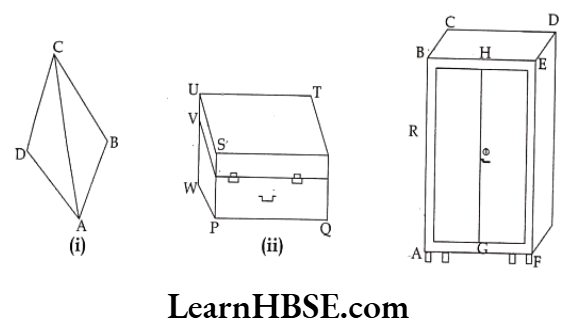
Solution. 1) Line segments: \(\overline{\mathrm{AB}}, \overline{\mathrm{BC}}, \overline{\mathrm{CD}}, \overline{\mathrm{DA}}, \overline{\mathrm{DB}}\)
2) Line segments: \(\overline{\mathrm{PQ}}, \overline{\mathrm{QR}}, \overline{\mathrm{RT}}, \overline{\mathrm{TU}}, \overline{\mathrm{UV}}, \overline{\mathrm{VW}}, \overline{\mathrm{SR}}, \overline{\mathrm{SP}}, \overline{\mathrm{SU}}, \overline{\mathrm{WP}}\)
3) Line segments: \(\overline{\mathrm{AB}}, \overline{\mathrm{BC}}, \overline{\mathrm{CD}}, \overline{\mathrm{BE}}, \overline{\mathrm{GH}}, \overline{\mathrm{EF}}, \overline{\mathrm{AF}}, \overline{\mathrm{DE}}\)
Question 9. Look at the adjacent figure. Answer the following questions.
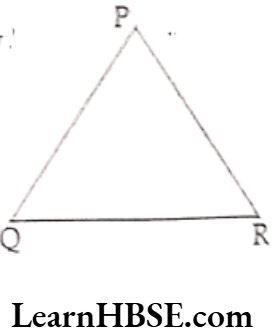
1) How many sides are there in the triangle? What are they?
Solution. 3 sides; They are: \(\overline{\mathrm{PQ}}, \overline{\mathrm{QR}} \text { and } \overline{\mathrm{PR}}\)
2) How many vertices lie on the triangle? What are they?
Solution. 3 vertices: They are P, Q and R.
3) What is the side opposite to the vertex P?
Solution. \(\overline{\mathrm{QR}}\)
4) What is the vertex opposite to \(\overline{\mathrm{PR}}\)?
Solution. Q
Question 10. Look at the given quadrilateral and answer the following questions.
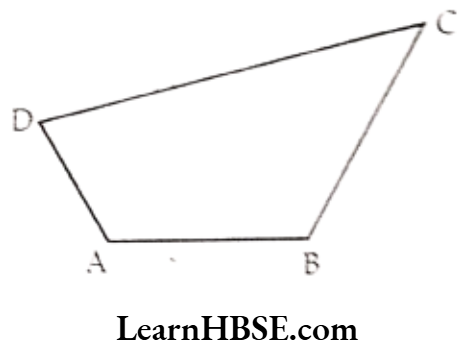
1) What are the sides of the given quadrilateral ?
Solution. Sides are: \(\overline{\mathrm{AB}}, \overline{\mathrm{BC}}, \overline{\mathrm{CD}} \text { and } \overline{\mathrm{DA}}\)
2) What is the opposite side of \(\overline{\mathrm{AB}}\)?
Solution. \(\overline{\mathrm{CD}}\)
3) What is the opposite vertex of B?
Solution. D.
4) How many pairs of adjacent angles are there? What are they?
Solution. Four pairs: They are ∠A and ∠B, ∠B and ∠C; ∠C and ∠D; ∠D and ∠A.
5) How many pairs of opposite angles are there? What are they?
Solution. Two pairs: They are ∠A and ∠C; ∠B and ∠D.
Question 11. Look at the adjacent figure and answer the following questions.
1) Write the name of this polygon.
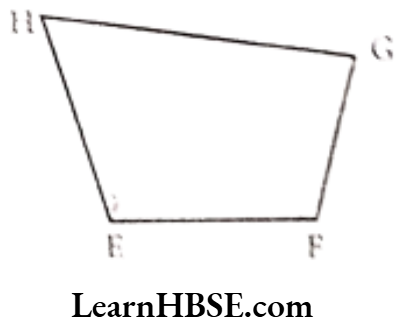
Solution. Quadrilateral EFGH
2) Write the pairs of adjacent sides and adjacent angles.
Solution. \(\overline{\mathrm{EF}}\) and \(\overline{\mathrm{FG}} ; \overline{\mathrm{FG}}\) and \(\overline{\mathrm{GH}} ; \overline{\mathrm{GH}}\) and \(\overline{\mathrm{HE}}, \overline{\mathrm{HE}} \text { and } \overline{\mathrm{EF}}\) are adjacent sides.
∠E and ∠F; ∠F and ∠G; ∠G and ∠H; ∠H and ∠E are adjacent angles.
3) Write all vertices, pairs of opposite sides and pairs of opposite angles.
Solution. Vertices: E, F, G, H
Pairs of opposite sides: \(\overline{\mathrm{EF}} \text { and } \overline{\mathrm{GH}} ; \overline{\mathrm{EH}} \text { and } \overline{\mathrm{FG}}\)
Pairs of opposite angles: ∠E and ∠G; ∠F and ∠H
Haryana Board Solutions For Class 7 Maths Chapter 5 Understanding Elementary Shapes Multiple Choice Question And Answers
Question 1. The angle above 180° and below 360° are called
- right angle
- reflex angle
- obtuse angle
- acute angle
Answer. 2. reflex angle
Question 2. Angle made by the seconds hand in 1 minute in a clock
- 30°
- 6°
- 60°
- 360°
Answer. 4. 360°
Question 3.
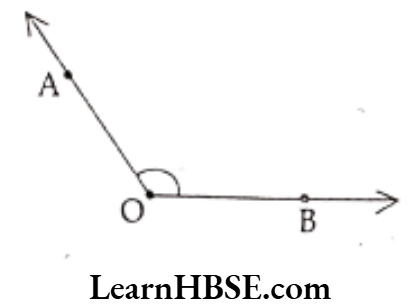
∠AOB is a ……. angle
- right
- acute
- obtuse
- zero
Answer. 3. obtuse
Question 4. The lines do not intersect are called
- parallel lines
- intersecting lines
- like lines
- unlike lines
Answer. 1. parallel lines
Question 5.
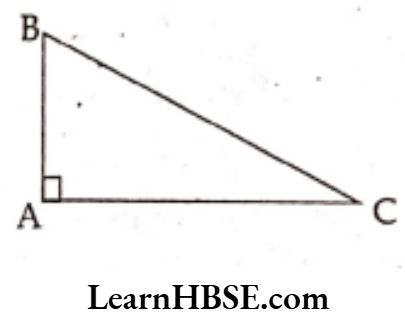
In the figure the right angle is
- ∠A
- ∠B
- ∠C
- BC
Answer. 1. ∠A
Question 6. Length of two line segments by
- simple observation
- tracing on a paper and comparing
- using instruments
- all the above
Answer. 4. all the above
Question 7. Each centimeter is divided into ………. parts in a scale.
- one
- ten
- hundred
- 15
Answer. 2. ten
Question 8. Angles are measured by using an instrument
- scale
- set squares
- divider
- protractor
Answer. 4. protractor
Question 9. ‘⊥’ symbol for
- perpendicular
- parallel
- intersecting
- none of these
Answer. 1. perpendicular
Question 10. 1 cm = ………… mm
- 1
- 10
- 100
- \(\frac{1}{10}\)
Answer. 2. 10
Question 11. Number of line segments of a triangle is ………..
- 4
- 3
- 2
- 9
Answer. 2. 3
Question 12. How many sides are three in a pentagon?
- 4
- 6
- 5
- 2
Answer. 3. 5
Question 13. Number of sides of a octagon is ……
- 3
- 6
- 8
- 7
Answer. 3. 8
Question 14. How many least sides are required to form a polygon?
- 1
- 2
- 3
- 4
Answer. 3. 3
Question 15. ………… is a fixed portion of a line
- line segment
- circle
- cone
- sphere
Answer. 1. line segment
Question 16. A reflex angle is larger than ………
- 180°
- 450°
- 390°
- 400°
Answer. 1. 180°
Question 17. Which of the following is an acute angle?
- 162°
- 75°
- 90°
- 110°
Answer. 2. 75°
Question 18. The measure of right angle is ………
- 90°
- 100°
- 190°
- 80°
Answer. 1. 90°
Question 19. A triangle having three unequal sides is called …… triangle.
- Equilateral
- Isosceles
- Scalene
- None
Answer. 3. Scalene
Question 20. Each angle in equilateral triangle is ……..
- 30°
- 40°
- 80°
- 60°
Answer. 4. 60°
Question 21. Polygon with 6 sides is called ………
- triangle
- hexagon
- pentagon
- octagon
Answer. 2. hexagon
Chapter 5 Understanding Elementary Shapes Fill in the blanks
Question 22. 175° is a ……… angle
Answer. obtuse
Question 23.

place the 1 mark (cm) of the ruler at A. Then the mark against B is 6.5 cm. the length of \(\overline{\mathrm{AB}}\) ………………….
Answer. 5.5 cm
Question 24. The unit of measuring an angle is a …………
Answer. degree
Question 25. Two …………….lines do not have any common point.
Answer. parallel
Question 26. Among 90°, 180°, 360°, 100° which is different ………..
Answer. 100°
Question 27. Degree is a ………. part of one revolution.
Answer. \(\frac{1}{360}\)th
Question 28. A ……… angle is more than a straight angle.
Answer. reflex
Question 29. The angle between perpendicular lines is ……..
Answer. 90°
Question 30. A protractor is a semi circular curved model with ……… equal divisions.
Answer. 180
Question 31. 359° is a…….
Answer. reflex angle
Question 32. “l and m are parallel lines”. The mathematical form of this statement ……….
Answer. l ∥ m
Question 33. The mathematical notation of the statement “l is perpendicular to m” is …………
Answer. l ⊥ m
Question 34. A ……………. is divided into 15 big parts as marked along one of its edges.
Answer. ruler or scale
Question 35. “Edge of a black board” is an example for ……….
Answer. line segment
Question 36. Hexagon contains ………. sides.
Answer. 6
Question 37. Number of diagonals of rhombus is ……….
Answer. 2
Question 38. A polygon with 8 sides is called …………..
Answer. Octagon
Question 39. A rhombus with 4 right angles is ………….
Answer. Square
Question 40. Two lines are perpendicular if the angle between them is …………
Answer. 90°
Question 41. The angle name for half revolution is ……….
Answer. Straight angle
Question 42. 1 mm …… cm.
Answer. 0.1
Question 43. A triangle is made of ……… line segments.
Answer. three
Question 44. Complete angle means ……..
Answer. 360°
Question 45. 115° is an example of ……. angle.
Answer. obtuse
Question 46. A polygon with 4 sides is called ………
Answer. quadrialteral
Chapter 5 Understanding Elementary Shapes Match the following
Question 47.
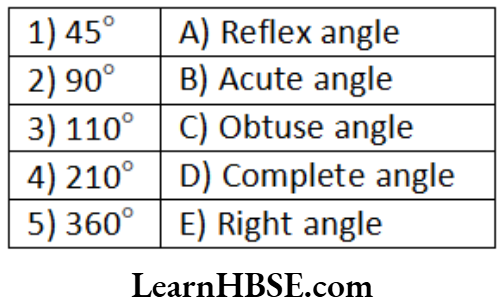
Answer. 1. 1-B, 2-E, 3-C, 4-A, 5-D
Question 48.
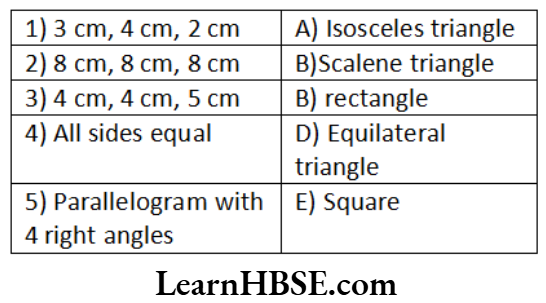
Answer. 2. 6-B, 7-D, 8-A, 9-E, 10-C
